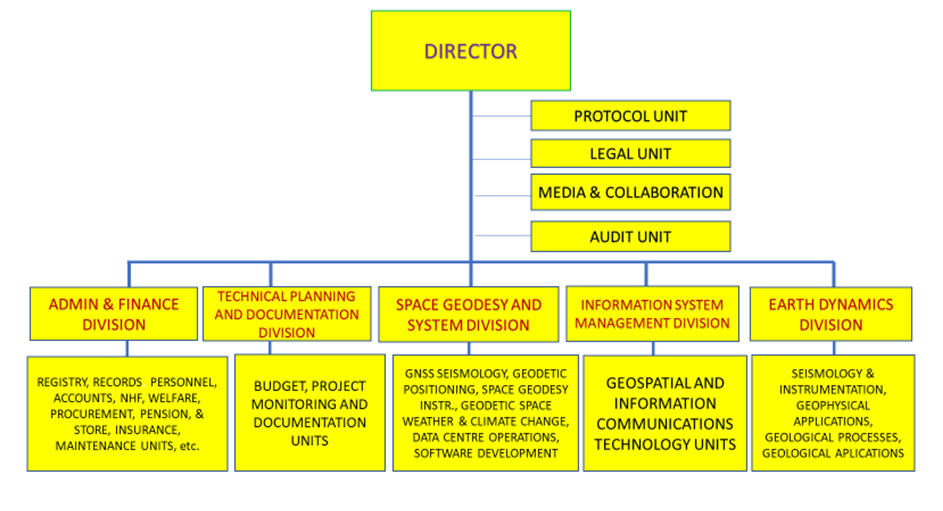Historical Background of CGG
The idea behind the establishment of the Centre for Geodesy and Geodynamics (CGG) was conceived as far back as 1985 when a National Technical Committee on Earthquake Phenomena (NTCEP) was inaugurated by the Federal Ministry of Science and Technology following the reported 1984 earth tremor in Ijebu-Ode and Ibadan, South-West, Nigeria.
In 1989, at the International Union of Geodesy and Geophysics (IUGG) general scientific assembly in Edinburg Scotland, during the International Association of Geodesy (IAG) session, Prof. D. M. J. Fubara, made a case for participation of African Nations in Global Earth Observing System and Global Deformation Monitoring. At the end of the meeting, it became obvious that, Africa occupies a strategic position in the Global Earth Observing System. Nigeria through the effort of the NTCEP indicated her interest in participating in global cooperative programme in Space Geodesy with the aim of providing new insight into African plate tectonics, global dynamics and the study of earthquake mechanism.
Due to the expertise required, by 1990, Nigeria secured, through the efforts of Prof. D. M. J. Fubara, collaboration with National Aeronautics Space Agency (NASA) and the steering committee of the International Coordination of Space Techniques for Geodesy and Geodynamics (CSTG); for the use of the Global Positioning System (GPS); Satellite Laser Ranging (SLR); and Very Long Baseline Interferometry (VLBI) to provide new insights into the African Plate Tectonic, Global Geodynamics and the study of Earthquake mechanism. The site to serve as observatory for these space techniques was selected in Toro, Bauchi State by Nigerian scientists and members of the National Technical Committee on Earthquake (NTCE) related phenomena constituted by the Nigerian Government. The Committee was charged with the responsibility of examining all factors that could lead to Earthquake and Earth tremor, volcanic eruption, landslides and other geo-hazard related phenomena. Toro site was subsequently certified by a delegation from the National Aeronautics and Space Administration (NASA) USA to be suitable for hosting the sensitive tracking systems; for monitoring global crustal dynamics. The choice of Toro as the observatory site is based on the solid geological bedrock (old granite) that can serve as immobile bed on which the tracking system can be situated.
In 1990, when the Observatory Site to house the Very Long Baseline Interferometry (VLBI), Satellite Laser Ranging (SLR) and Global Positioning System (GPS) equipment was to be selected, Professor Fubara who was the first Geodesist in West Africa led some Nigerian scientists with the NASA officials to Toro. They carried out their assignment successfully.
The choice of Toro site was based on solid geological bedrock (the “older granites”) that can serve as immobile belt on which Sensitive tracking systems can be situated. The selected site shall, in addition to Satellite tracking, be responsible for the monumentation and footprints survey in accordance with guidelines of the space Geodetic Measurement sites sub-committee of the international coordination of Space Techniques for Geodesy and Geodynamics, and Global mean sea level monitoring network station at Bori, Rivers State.
Establishment of Centre for Geodesy and Geodynamics
In January 2002, the CGG was established following the approval of the National Space Policy and Programmes by the Federal Executive Council in May, 2001, with Mr. T. A Yakubu, as the pioneering Coordinator, now Dr. T. A. Yakubu as the Centre Director.
The Centre hosted the 1st International Workshop on Geodesy and Geodynamics in Nigeria on Thursday, 10th February, 2005.
Mandate CGG
The eventual goal of the Centre’s programme which constitutes its mandate, is to achieve Nigeria’s capability, manpower and hardware development that can sufficiently address the following national issues: Space Geodesy, Crustal deformation, Coastal deformation and subsidence, and global mean sea level monitoring.
The context of the mandate is therefore, dedicated to the study of crustal and coastal movements within the context of the Nigeria older basement complex as well as the West African craton using space geodetic and geophysical techniques.
Mission Statement
The mission of the Centre is to carry out earth observation research as well as monitor and predict geo-hazards using Space Geodetic and Geophysical Techniques for sustainable National Development. This involves areas such as: Crustal and Coastal Deformation monitoring; Subsidence; Landslide; Flood and Global Mean Sea Level Monitoring; the provision of products and services with the geodetic accuracy necessary to address important geophysical questions and societal needs, and to provide the robustness and continuity of service which will be required in order to meet future needs and make intelligent decisions.
CGG Structure
To achieve its mandate, the Center for Geodesy and Geodynamics, Toro, is structured as represented in Figure 2. There are five major Divisions: The Administration and Finance; four technical Divisions namely: Space Geodesy and System, Earth Dynamics, Technical Planning and Documentation, Information System Management. The International/Local Collaborations, Audit, Legal, Media and Protocol units are under the Office of the Director

